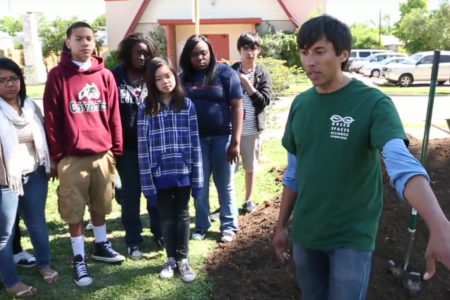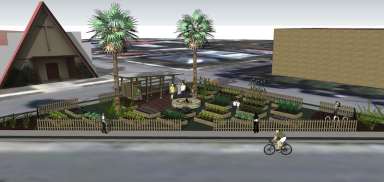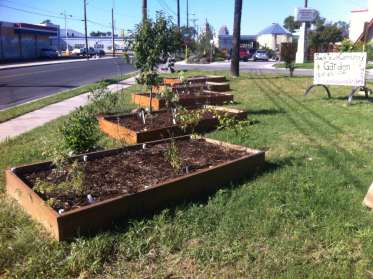Share On Social!
Caesar Valdillez loves where he lives—the Southtown neighborhood in San Antonio (63% Latino).
He grew up in the neighborhood and even moved back after he finished college, hoping to meet like-minded environmentalists to improve the neighborhood and sustain it for many years to come.
But he noticed Southtown lacked the healthy food options it needed to be a truly healthy community.
“Our neighborhood does not have any reasonable grocery store in the area, especially with fresh produce and herbs,” he said.
He decided to help.
Southtown Lacks Healthy Options
In 2010, on a routine neighborhood walk, Valdillez stumbled upon the South Presa Community Garden.

It was largely neglected and overgrown.
He was “immediately intrigued,” though, when he saw at least a few neighbors getting involved in gardening as a means to increase healthy food options and neighborhood sustainability. Latino neighborhoods tend to lack healthy food options, especially in urban areas, according to Salud America! research.
So Valdillez joined the South Presa Community Garden.
Land for the garden was originally acquired in 2007 through a multi-year lease between neighbors and a private landowner.
The landowner decided not to renew the lease because there were few remaining neighbors participating.
With the garden’s future in danger, Valdillez had a new vision.
“I realized the great potential for the establishment of a new Southtown Community Garden,” Valdillez said. “Not only would we be able to offer cheap, if not free, bounty of the garden to ourselves and anyone who wanted to participate [but people could also] grow their own.”
A New Lease on Gardening
For Valdillez and other folks who worked so hard on the South Presa Community Garden, they didn’t want the end of their lease to mean the end of their garden.
So they called a group meeting and asked themselves a question.
“Are we going to start over somewhere else, or give up?’” Valdillez said. “The vote was unanimous to start a new garden.”
The group immediately began to scope out new locations in their Southtown neighborhood and narrowed it down to three spaces—all city-owned properties.
Learning from their previous garden, from which they were essentially kicked out, Valdillez said the group decided that “the land we acquire should be a public space and not privately owned.”
A public city space, although not subject to the discretion of a single landowner, still has to clear several hurdles—namely, developing an agreement to use the land for gardening and other activities.
Besides wanting a public space, the gardeners had some other criteria for their new plot of land. They wanted a smaller spot than before; smaller meant easier to maintain. They also wanted the plot to have easy access to water, essential for growing a garden.
The group visited successful community gardens around San Antonio to see what worked for those gardens, and how they might replicate that in Southtown. They also sought backing from the Southtown neighborhood association (they got this support, although not until after the new garden began).
Selecting a New Garden Home

Source: Caesar Valdillez
http://southtowngarden.org/
The gardeners weighed their options and selected a small, unused, underdeveloped triangular pocket park right in the middle of one of Southtown’s major roadways.
Marc Toppel, the official garden steward/manager at the time, contacted the City of San Antonio Parks and Recreation Department in February 2012 about developing the land at the triangular pocket park for their new garden space.
Toppel then met Phillip Covington, a consultant at Parks and Rec. Then, the city got to work.
“We made sure that the property was assigned to Parks and Rec, that we maintained it,” Covington said. “We had to verify that there were utilities available…if there was a meter…they needed water for irrigation.”
Next, the pair discussed the basic terms for a memorandum of understanding (MOU) between the city and the gardeners, which Toppel and Convington had decided was the best type of policy to fit the gardeners’ needs.
A memorandum of understanding is a written agreement between two parties that outlines expectations with a common goal in mind; in this case, the common goal is a community garden benefiting the Southtown neighborhood. An MOU is easy to create and generally simple and straightforward—not as restrictive as a contract but more formal than a just a handshake.
The pair discussed the city’s requests of the gardeners (in exchange for the land): that the gardeners would agree to take on the primary responsibility of maintaining the plot (although the City would still mow the grass and provide free water), and that the land had to be open to the public and gardeners could not discriminate against anyone who might want to participate.
“Once we discussed the terms, we took the agreement to our parks [and recreation] board,” Covington said.
The San Antonio Parks and Recreation Board is made up of one person from each council district in the city, usually appointed by that district’s council person.

Once the MOU was approved by the board, it was signed administratively by the director of Parks and Rec and by also by Toppel on May 25, 2012.
The whole process took about three months, which is typical for new agreements, Covington said.
The new Southtown Community Garden was now official.
The MOU granted the use of the land for five years to establish a community garden in San Antonio’s historic downtown neighborhood.
Getting Neighbors to Connect, Garden
The group had permission to use the land, but a successful community garden needs more than a signed agreement.
It was up to the neighbors to get out there and garden, Valdillez said.
Knowing that there is strength in partnerships, the group began a partnership with Green Space Alliance (GSA), a local environmental organization. They signed a five-year contract with GSA and transferred their small remaining budget to the newly named Southtown Community Garden.
Valdillez, fresh out of graduate school, decided to take on the role as official steward/manager of Southtown Community Garden. The Southtown Community Garden officially “broke ground” in late May 2012.
Southtown Community Garden has to keep open communication lines with the city. When they wanted to begin building a fence and install a water catchment system, they had to get the city’s approval. The same goes for when they want to host events in the garden.
“We did everything entirely by the book and have the backing of the city, the Green Space Alliance, and ultimately the community, whose involvement has continued to grow,” Valdillez said.
Called by the urban gardeners “the people’s garden at the triangle,” the Southtown Community Garden is available to anyone interested.
“The SCG is set up to be a mix of open community beds with the option of buying into a membership,” Valdillez describes.
A membership, which is $20 a year and goes directly back into garden maintenance, materials, tools, soil, gives folks the option of acquiring a private half-bed (4’X4”) to grow whatever they wish, along with a few perks like an official SCG T-Shirt, a vote in the SCG steering committee and first pick of the community bounty if they choose. You don’t have to be a member to reap the benefits of community gardening.
“The community beds are open to anyone in the community wishing to utilize the public green space,” affirms Valdillez.
He makes it clear that they encourage anyone and everyone to get involved.
“If one has the desire to contribute to making the community a better place to live, access to grow natural healthy foods, and learn about ways to be self-sufficient and sustainability in several areas, then you’re in.”
The bounty of the garden is planned for a variety of uses. Individuals who don’t have access to green space for growing at their homes or apartments can use space in the SCG to grow their own healthy veggies, fruits, herbs or native plants.
A few restaurants in the Southtown community have expressed interest in purchasing plot space to grow their own healthy foods to utilize in their restaurants, offering the freshest produce and herbs grown right in their backyards.
As the garden continues to grow and more beds are established, the group imagines they will have an abundance of extra produce. They plan to offer this surplus to organizations that will use it to feed the homeless, or distribute to folks in need of fresh, natural grown food.
For Valdillez and his neighbors, it’s all about making their community better for everyone.
“Urban gardening is our grassroots way of making a difference in the world, one preserved green space at a time,” Valdillez said.
By The Numbers
1
Supermarket
for every Latino neighborhood, compared to 3 for every non-Latino neighborhood
This success story was produced by Salud America! with support from the Robert Wood Johnson Foundation.
The stories are intended for educational and informative purposes. References to specific policymakers, individuals, schools, policies, or companies have been included solely to advance these purposes and do not constitute an endorsement, sponsorship, or recommendation. Stories are based on and told by real community members and are the opinions and views of the individuals whose stories are told. Organization and activities described were not supported by Salud America! or the Robert Wood Johnson Foundation and do not necessarily represent the views of Salud America! or the Robert Wood Johnson Foundation.



